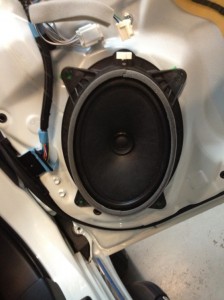 Sometimes I think there is some kind of “Think Tank” that automobile manufacturers attend. At this “Tank” are a bunch of people who are all devising ways to irritate anyone who dares to replace anything they are generous enough to include in the price of the vehicle. Toyota has done a great job doing this with their front 6×9” speakers that are in some of their vehicles.
Sometimes I think there is some kind of “Think Tank” that automobile manufacturers attend. At this “Tank” are a bunch of people who are all devising ways to irritate anyone who dares to replace anything they are generous enough to include in the price of the vehicle. Toyota has done a great job doing this with their front 6×9” speakers that are in some of their vehicles.
The vehicles that have lucky owners are; 07-11 Camry and FJ Cruiser, 08-11 Highlander and Sequoia, 02-06 Camry, 05-11 Tacoma and last but not least the 10-11 4-Runner. The best part is the Car Audio industry as a whole is not even in full agreement as to what sizes belong. We’ve looked up some of these vehicles while preparing an estimate for customers and the wrong size speaker is listed.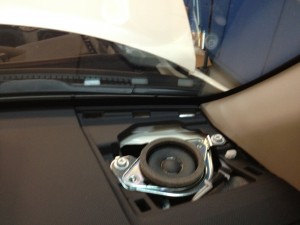
To add to this confusion the 6×9” speaker is often accompanied by a tweeter in the door or dash. I’m not familiar with every single aftermarket speaker company out there however, the component 6×9 is not very common and until this year it was never something we carried. I’ll get to that speaker later on.
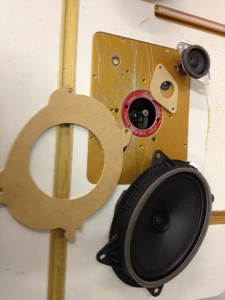 In the past if a customer had a separate tweeter and wanted to replace that tweeter we would sell them a 6.5” component set and build adapters to house the 6.5” speaker in a 6×9” hole. The extra time and material would add to the bottom line for the customer. If the customer didn’t care to replace the tweeter we would sell them a 6×9” coaxial pair of speakers.
In the past if a customer had a separate tweeter and wanted to replace that tweeter we would sell them a 6.5” component set and build adapters to house the 6.5” speaker in a 6×9” hole. The extra time and material would add to the bottom line for the customer. If the customer didn’t care to replace the tweeter we would sell them a 6×9” coaxial pair of speakers.
The size issue isn’t the main cause of this blog. The biggest issue is the housing the Toyota factory speakers are in. It’s more like a contraption. The circumference of the speaker and the hole it fits in are the same size. That’s highly atypical. An aftermarket speaker will fall right through, 6×9” or not. The factory speaker does not fall through because of the housing or basket that wasdesigned to hold the speaker in place. (I wonder how much more money was spent on this brilliant design and how much the design brilliance and use of extra material it costs the customer.)
Basically, there is a plastic housing the speaker sits in and that housing is bigger than the speaker. That housing has 4 extensions, one in each corner that extends from the housing and is used as the location for the screw holes. The housing is the reason for needing to build speaker adapters to mount the new speakers and match up to the screw holes. Notice I 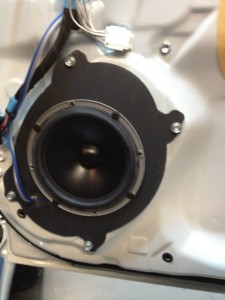 said “build”. Building is far better than trying to make a generic 6×9” speaker adapter do the work. Can you say “rigging”? Rigging often leads to shaky. Shaky leads to a customer bringing that shaky, rigging of a speaker install to our store for troubleshooting and pictures taken for our “crap install” photo album we keep for what not to do. Rigging will be necessary because generic 6×9″ adapters will still not fit the Toyota specific mounting holes.
said “build”. Building is far better than trying to make a generic 6×9” speaker adapter do the work. Can you say “rigging”? Rigging often leads to shaky. Shaky leads to a customer bringing that shaky, rigging of a speaker install to our store for troubleshooting and pictures taken for our “crap install” photo album we keep for what not to do. Rigging will be necessary because generic 6×9″ adapters will still not fit the Toyota specific mounting holes.
How can a customer prevent the rigging install and predict which stores will use the rigging technique? First of all, let’s hope the customer asks the cost of everything before the installation begins. Most likely, the sales person will give their generic answer and not until the car is pulled around to the garage and the door panels are off does the sales person find out that this isn’t the generic speaker install. The installer will advise the issue and how much more it will take. When the customer is told about the extra costs and if it’s a Toyota with 6×9” speakers, the customer should ask the following:
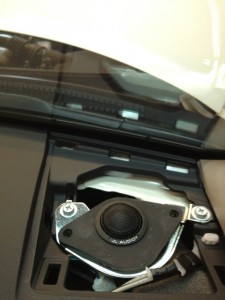 “What are you using that costs extra?” If the store employee says speaker adapters ask; “What are they made of?” If the employee says plastic the customer should either say never mind based on them using plastic (which are the generic ones) or the customer should ask if the store has use of a router table to build the adapters to match the space. If the store does not have a router table then this is a store that has very little fabrication experience and rigging is their only choice and probably a common one. From there, it’s a gamble for the customer.
“What are you using that costs extra?” If the store employee says speaker adapters ask; “What are they made of?” If the employee says plastic the customer should either say never mind based on them using plastic (which are the generic ones) or the customer should ask if the store has use of a router table to build the adapters to match the space. If the store does not have a router table then this is a store that has very little fabrication experience and rigging is their only choice and probably a common one. From there, it’s a gamble for the customer.
There is one other not so crazy choice. Building a mounting ring to fit to the oddly placed mounting holes is still necessary for the Toyotas, however it will just be the trim piece to mount the speaker to and not to convert a 6.5” new speaker to a 6×9” space. Just this year we discovered a product made by Kenwood. There are two models; the KFC-X183C which is a coaxial and the KFC-XP184C which is component. They are each oversized or 7” round speakers. They will fit in an oversized 6.5” speaker location which does occur sometimes and a 6×9” space without using any kind of speaker adapter because it brilliantly includes one; Ta-dah! This product is great for the later model Chrysler, Jeep, Dodge vehicles that all seem to come with 6×9”speakers as well, but without the headache of many of the Toyotas where building mounting rings are necessary.
Why choose these speakers? First, since they already include the 6×9” adapter they are easier to install and therefore a little easier on the customer’s pocket. Second, they sound good. We consider them to have good quality sound. There are better and higher quality speakers but if you are just trying to replace bad speakers these are a great choice and fit. They are around 80 watts RMS each speaker and therefore can transition into an amplified system very well.
Pictures top to bottom: All pictures were taken while installing new JL Audio C5-650 speakers into a 2012 Toyota 4Runner. The top picture shows the factory 6×9 in the front passenger door. Next is a picture of the factory 4″ tweeter in the dash. Third, is the factory 6×9″ speaker and factory tweeter at the routing table along side the replacement adapters and mounting rings. Fourth, the new 6.5″ JL Audio mid driver installed in the same door. Last, the JL Audio companion tweeter mounted in the dash.

Adam
Add the 07+ Tundra to the list
crhoades
Thanks Adam. How’s it going? Yeah, I knew when I listed the vehicles that I was missing some because I was going by a spec list and that is not always correct. I couldn’t remember them all.
Wesley Nelson
So am I understanding this right? The above mentioned Kenwood speakers come with the bracket to mount new 6×9’s? It requires no additional brackets? I have a 2012 Camry that I believe houses such problematic factory speakers.
crhoades
No. The Kenwood speakers are 7″ round and come with a 6×9″ template to fit the round speaker in an oblong space. However, the Toyota 6×9 is mounted in an even larger mount or encasement and so bigger wood inserts need to routed out to fit the oddly shaped Toyota space itself. We recommend the Kenwood 7″ speaker with the separate tweeter if you have a Toyota because decent 6×9″ component speakers (ones with separate tweeters) are hard to come by. You can put a regular 6.5″ speaker in there or if you find a 6×9″ component set for the front doors you can use that but however you do it you will have to build some kind of wood insert to house your new speakers.
Tod
What about the back doors on the quad cab are they have the same problem
crhoades
Typically on any Toyota speaker, there is some kind of issue. Whether it’s a 6×9 or 6.5″ Not knowing the year or model of your truck I cannot be more specific. The easiest speakers on a Toyota will be the older models, meaning 90’s and older and the Camry’s rear deck 6x9s. There is no customizing on the rear deck of a camry however, you have to completely remove the rear seat, rear deck and I think the side panels next to the rear deck just to get the speakers out. Either way, if it’s not a weird fit that needs cutting is a problematic install regardless.